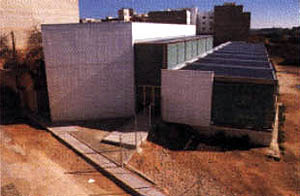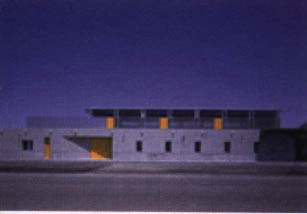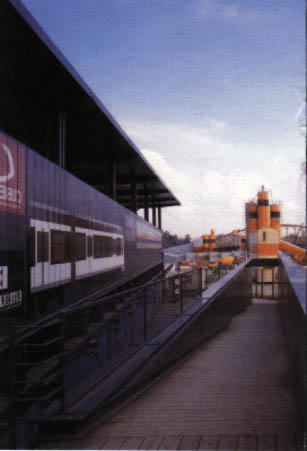Hoy en día existe elpeligro de los "media", auténticos caníbales de la producciónde las artes figurativas que reproducen hasta la saciedad los "idola fori" arquitectónicos, o se nos propone el conocimiento de la arquitectura internacional mediante eluso de procesos informáticos vía internet o cualquier otro soporte.
Hace casi un cuarto de siglo, la crisis del petróleo provocó un impulso creciente hacia la producción teórica de la arquitectura. Los escasos encargos en los estudios profesionales hizo posible la aparición de plataformas que, de una u otra manera, culminaron en publicaciones alacanzando cotas de calidad no superadas actualmente y me refiero sobre todo a la revista Oppositions que desde el Instituto de Arquitectura y Estudios Urbanos de Nueva York impulsó el lanzamiento de esta publicación (Diario de Ideas y Crítica de Arquitectura). Y al socaire de Oppositions surgieron en otros ámbitos revistas de arquitectura hermanadas con ella. italia conoció días de esplendor arquitectónico con Lotus y España con Arquitecturas-Bis que, a pesar de la modestia de su lanzamiento (inteligente operación editorial de Rosa Regás), consiguió reunir en sus páginas lo mejor de laprofesión arquitectónica española, divulgar a través de ella las transformaciones de la modernidad que se estaban produciendo en el mundo occidental y establecervínculos editoriales con la italiana Lotus y la americana Oppositions a través de reuniones de los consejos de redacciónde las tres publicaciones. Hecho insólito en la publicación de revistas de arquitectura. No onstante, este periodo de producción teórica se agotó probablemente por las demandas de "nueva" arquitectura que se produjeron en la década de los 80, aunque como dice Jauss, en determinados círculos de la teoría crítica se impugnó lapretensiónde que un movimiento, autodefinido por su carácter de post, pudiera optar a laseriedadde una nueva conciencia de época. "Loprimero que sse dio a conocer como algo muy difuso enel plano literarioy como propuestas innovadoras concretas de cambio de estilo en la arquitectura, fue atribuido en alemania por la crítica idológica a una antimodernidad política y a una antiilustración neoconservadora, alserviciode las necesidades de la cultura de masas, en apariencia estéticas, pero en realidad controladas por los medios de comunicación".
Buena prueba de ello es que las revistas de arquitectura reciben por igual el flujo inforático del mundo tecnificado y mezclan despreocupadamente la alta cultura y la cultura de masas en su afán de aprovechar la ficción, lo imaginario y lo fantástico en favor de abrir la arquitectura a un mundo altamente industrializado en cuya base se encuentran los medios de comunicación que cada día exigen nuevas imágenes para retroalimentarse. Hace apenas unosaños acceder a esta información arquitectónica exigía suscripciones a las revista directamente o a través de librerías especializadas, hoy en día cualquier fiosco medianamente provisto de publicaciones periódicas es capaz de ofrecer las últimas novedades arquitectónicas nacionales o extranjeras.
En otras ocasiones me he pronunciado sobre la reivindicaciónde unas señas de identidad valencianas asimilables a la arquitectura y esta cuestín sólo la entiendo como manifestaciónde identidad cultural, lingüística, paisajística y climatológica ligada a los tres países de cultura catalana. Un somero repaso a las arquitecturas pretéritas o recientes de Cataluña, Valencia y Baleares volverían a confirmar este supuesto, que podría sintetizarse en: preferencia hacia la abstracción, pragmatismo ante las decisiones y la elección de materiales y uso de sistemas pasivos para temperar las variaciones climáticas.
Pero divulgar la producción arquitectónica producida en la Comunidad a través de las páginas de esta revista es el objetivo del empeño tanto por lo que se refiere a obra construida como a proyectos provenientes del ámbito académico de la Escuela de Arquitectura de Valencia que hayan merecido reconocimmiento internacional.
Es el caso de la propuesta presentada por Paula Cardells y Gabriel García con Mejías, Flores, Penadés y Marco,
Previous attempts failed when faced with the scarcity of suitable pictures or theoretical material or perhaps as a result of the scant support given to it by the sponsoring body. It does not seem pertinent to compete with existing journals in so far as the cultural offer comes from somewhere on the sidelines. However, if this imbalance could be righted with the commitment to a more imaginative editorial policy, a more rigorous selection of the contents, an unearthing of specific architectural events of the recent past confined to the obscurity of other disciplines which would help us to understand the changes undergone by this century now coming to a close, then the outlook for the continuity of the journal would seem brighter.
The danger today is to be found in the mass media. They are cannibalising the output of the figurative arts by reproducing ad nauseam the showpieces of world architecture or invite us to discover international architecture by recourse to computer technology, to the Internet or similar medium.
Almost a quarter of a century ago, the oil crisis caused an increasing shift towards architectural output in theoretical terms. The few commissions received by professional studios facilitated the appearance of platforms from which publications were launched of a quality unsurpassed hitherto. Y refer especially to the journal oppositions to the publication of which the New York Institute of Architecture and Urban Studies gave the necessary impetus under the wing of this logbook of ideas and critical appreciation of architecture sprang journals of like ilk. Italy basked in the Architectural Splendour of lotus and Spain in that of Architectura-bis, which, despite limited resources, and intelligently guided by Rosa Regás, Gathered within its pages the cream of the Spanish architects with the aim of making known to a wider public the changes taking place in the western world and establishing publishing links with lotus and opposition though meetings of the three editorial boards. This in itself was unusual in journals of architecture. Nevertheless, this period of theoretical output started to wear thin probably as demands for "new" architecture increased in the eighties, although, as Jauss says, in certain circles of theoretical criticism the movement’s credentials, (self-styled post), to seriously represent the new conscience of an era, came under fire.
"The first thing to be given wide coverage in the literary field and as innovative and specific proposals for a change of style in architecture, was attributed in Germany by its ideological critics to a political stance against modern influences and to a neo-conservative anti-enlightenment at the beck and call of the needs of mass culture; though, apparently of an aesthetic nature, these needs were under the control of the mass media".
This is all too evident in the fact that journals of architecture feed on the products of information technology, and, unconcerned, mix haute culture and mass culture in their eagerness to exploit fiction, imaginative and fantastic resources in order to crease an opening for architecture in a highly industrialised society. In its very foundations we find the mass media in a constant search for fresh new images with which to seek feedback. Only a few years ago, access to this architectural information required subscribing to journals either directly or via specialised bookshops. Nowadays, any moderately well-stocked newsagent is able to provide the latest literature on national or international architectural issues.
On other occasions, I have mentioned the right of incorporation of characteristic regional features of Valencia to architecture. By this, y am referring exclusively to a manifestation of a cultural, linguistic, geographic and climatic identity which links the region of Valencia, Catalonia and the Balearic Islands within a commonly shared Catalan culture. A quick glance at the past or recent architecture of these regions serves to substantiate a fact which can be summarised thus: a preference for abstraction, a pragmatic approach to decision-making and the choice of materials and use of passive systems to temper climatic variations.
However, spreading the word about the architectural output of the region of Valencia via the pages of this journal is the principal objective as regards both internationally acknowledged finished constructions and plans and costings coming from the academic section of the Valencia School of Architecture.
Such is the proposal presented by Paula Cardells an Gabriel García with Mejías, Flores, Penadés and
Dentro de las obras promovidas por la Conselleria de Sanida y Consumo de la Generalitat, sobresale el Centro de Salud de Villamarchante [3], obra adjudicada mediante concurso a Juan Deltell y Francisco Nieto, ambos profesores del Departamento de Proyectos de la ETSAV y que, frente a un programa fragmentado, consiguen dar unidad a una serie de cuerpos bien definidos con diferente contenido funcional y unos niveles de abstracción que consolidan esas señas de identidad que a menudo reivindacamos para nuestra arquitectura.
El recinto ferial de Alicante [4], obra de Miguel del Rey e Íñigo Magro conjuntamente con Miguel Martín, pertenece a ese paquete de obras promovidas por la administración. Los autores salen doblemente airosos de la hazaña al rentabilizar unas antiguas instalaciones comerciales dotándoles de la oportuna monumentalidad que subraya el carácter del edificio. Obras de formato más reducido (Del Rey-Magro) son las lonjas de pescado en Santa Pola y Villajoiosa [5], que muestran el rigor y la economía de medios de sus autores. La arquitectura escolar está representada por una escuela infantil [6] proyectada y dirigida por María Jesús Rodríguez y Miguel Campos, quienes conjugan la escala doméstica del conjunto con una depurada realización. La vivienda unifamiliar ha sido a lo largo de este siglo el modelo de laboratorio donde experimentar la arquitectura. Las imágenes de la casa en Lliria [7] de Vicente Guallart recuerdan aquellas propuestas que trataron, desde diversas actitudes, cambiar el concepto de vivienda o por lo menos intentarlo. Concebida como un "loft" neoyorquino, se observa una fijaciónpor expresar una pretérita modernidad a costa de renunciar a unos planteamientos domésticas destinados a alcanzar los niveles deconfort deseables en este tipo de construcción. Lavacación leocrbusierana de esta casa se confirma en la memoria que acompañala información gráfica, desde el deseo implícito de una máquina de vivir al paseo arquitectónico o a la imagen surreal de la bicicleta estática en la pieza principal, tratando de buscar la esencia de la arquitectura no en su propia naturaleza sino en algo exterior a ella: la máquina. El uso del trampantojo enlafachada sur o el césped artificial de la terraza e interior nos remitena insulsa propuestas de modernidad.
La fábrica INELCOM [8] en Xátiva, obra de Carmel Gradolí, Luis F. Herrero y Arturo Sanz ejemplifica el tono general de la nueva arquitectura valenciana, abstracción y pureza volumétrica, implantación discreta en el medio construido, utilizaciónde elementos pasivos para economizar energía y conseguir delicadas transparencias visuales.
Finalmente, deseo hacer mención a dos artefactos arquitectónicos con carácter efímero. Uno de ellos es el pabellón del metro [9] que, situado en el antiguo cauce del Turia, fue escaparate propagrandístico de esta obra civil. Su autora, Lurdes García Sogo supo expresar mediante unaacertada síntesis los recorridos didácticos y la depuración formal idónea para eltipo de encargo institucional. El segundo ejemplo es el stand Firamaco-96 [10], perteneciente al Colegio Territorial de Arquitectos de Alicante, obra de Armando Sempere, acertado modelo minimalista oportuno para esta clase de exhibición.
El lector tiene ocasión de ver reflejadas en las páginas de la revista las obras presentadas e incluso algunas más con la intención de estimular la reflexión y el debate arquitectónico desde esta nueva plataforma de divulgación.
Marco, for the
U.I.A. competition. "Group of houses in the Raval of Barcelona" [1] which was awarded top prize from among one thousand competing entries to the best design by the Japanese Architecture Institute [J.A.I.] based in Tokyo. The attraction of the winning entry can be seen from two angles. A literary one to be found in the actual written paper of the plans, where art and life commingle in the authors’ descriptions and in their general reflections on the field of architecture to explain the ideas behind the plans submitted. The second angle, which is explored by means of the drawings, expands on the previous literary presentation. The final result takes us back to those idealistic situations of the sixties [Yona Fridman] who strove to create public spaces half-covered by ones at different heights and scales with the intention of fluffing up the tight, colourful weave of urban architecture. Example of public architecture found in this journal funded by local government can be seen throughout the region of Valencia. One of such buildings is the Edificio Delegación del Impiva [2] in Alicante by Lola Alonso and Javier García Solera where the emphasis is on a refined abstraction and a solid yet discreet presence of the architectural subject. Others are the brilliant constructions for the University Campus in Alicante by Alfredo Payá and García Solera. The list of public works extends to areas such as Health and Social Security, Education etc...Among the outstanding works funded by the regional Ministry on Health is the Villamarchante Medical Centre [3], a work put out to tender and awarded to Juan Deltell and Francisco Nieto, both lecturers at the Department of Plans and Costings of E.T.S.A.V. and who, faced with a fragmented programme manage to give a sense of unity to a series of well-defined blocks with differing functional content and a level of abstraction designed to consolidate these regional features we think ought to be reflected in our local architecture.
The Alicante Trade Fair [4] site by Miguel de Rey and Iñigo Magro together with Miguel Martín, belongs to this series of works funded by the regional government. The authors acquit themselves well on two counts: they exploit some old commercial premises and impart on them a fitting monumental character. Smaller works [Del Rey-Magro] are the fish markets of Santa Pola and Vilajoiosa [5] which show a precision and economy of resources.
School architecture is represented by a primary school [6] planned and directed by Mª Jesús Rodríguez and Miguel Campos who combine domesticity with a refined finish.
Detached housing has, throughout this century, served as the guinea pig of architecture. The photographs of the house in Lliria [7] by Vicente Guallart bring to mind those attempts made to change the concept of a family dwelling. Built in the style of a New York loft, it expresses a modern atmosphere of times gone by at the expense of doing away with the trappings of comfort so much sought after in this day and age. The influence of Le Corbusier is confirmed in the report accompanying the drawings and plans, starting from a desire to see it in terms of a machine with which to live an architectural concept or the surrealistic image of the exercise bicycle in the main room. The essence of architecture is not in its own nature but in something outside of it: the machine. The use of trompe l’oeil in the south facing front or the artificial grass of the terrace suggest the insubstantial nature of modernity.
The INELCOM factory [8] in Xátiva by Carmen Gradolí, Luis F. Herrero and Arturo Sanz exemplifies the general tone of the new architecture of Valencia, abstraction and purity of volume, discreet setting within the building medium, the use of passive components to save energy and achieve a delicate visual transparency.
To end with, I should like to mention two temporary architectural artefacts. One is the pavilion for the Valencia underground [9], which is situated on the bed of the river Turia (now bypassing Valencia) and which has been the publicity showpiece of this public work. The architect, Lourdes García Sogo managed to express the didactic qualities of a work of this kind in a successful style of synthesis and refinement. The second example is the stand of Firamaco-96 [10] belonging to the Colegio Territorial de Arquitectos de Alicante. This work by Armando Sempere is a well-designed minimalist model which harmonises perfectly with the exhibition setting.
The reader is invited to look at the buildings described in the pages of this new journal. Even though there are others which are not mentioned, I hope they will lead to fruitful reflection and debate from this new stimulating forum of things architectural.









